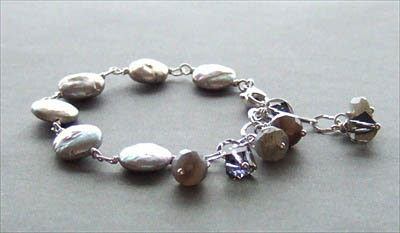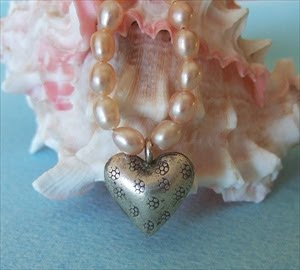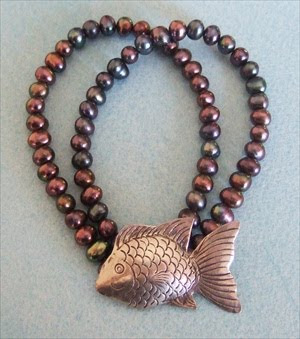


I adore pearls. They are unquestionably feminine.
Pearls are the only gem that comes from a living organism. Generally we think of pearls as coming from oysters. These are saltwater pearls. Freshwater pearls, however, are grown in mussels. Natural pearls have become very rare. Over-fishing of the natural pearl beds over the past 150 years led to many of the natural pearl beds being permanently depleted.
There are still wonderful cultured saltwater pearls. Because saltwater pearls are pricey and not affordable to many people, I use mostly freshwater pearls. There are beautiful freshwater pearls that are very reasonable in cost, and there are exquisitely beautiful and rare freshwater pearls that are are very, very expensive.
Most freshwater pearls are farmed. An object called mantle is placed in the mussel. This stresses the mussel as sand in an oyster and it produces calcium carbonate around the mantle. Many pearls can be produced in one mussel. It can take several years for a pearl to grow to what we think of as medium size - 7 millimeters or so. Nacre, or crystallized calcium carbonate is the substance the mollusk produces, and which gives pearls their lustrous beauty. The mollusk produces nacre in starts and stops, and most often unevenly, which gives pearls their interesting shapes and ridges.
Over time the mollusk produces layers and layers of nacre. The many layers of nacre act as prisms when the light shines through them. This creates the iridescent colors in the pearl. Keishi (or keshi) pearls are pure nacre.
Freshwater pearls grow in a wide variety of colors and shapes, depending on many factors. Some pearls are also dyed and irradiated to achieve their color.
In terms of shape, perfectly round freshwater pearls are a little hard to come by. Some of the most common shapes are rice shaped (oval), potato shaped (they look like little potatoes - cute), nugget, button shaped and rondelle. Then there are the more unusual shapes, such as petal pearls, coin pearls and baroque pearls.
Actually, pearls take an endless variety of shapes. Generally speaking, small pearls are less expensive than large ones, but there are numerous variables, such as luster, shape, and color that influence the monetary value of pearls. Generally the luster of a pearl is the major factor that makes a pearl desirable.
Because pearls are soft and easily worn, many jewelers and jewelry designers believe pearls should be strung on silk, or at least nylon. Silk also gives pearls a nice drape and makes them look very graceful and fluid when they're worn. If there is metal in a piece of pearl jewelry such as gold or silver beads or pendants I use very fine, smooth plastic coated wire instead of silk. The metal tends to wear silk and the cord can easily break.
I became addicted to jewelry making after stringing my first strand of pearls. They were so beautiful. I still love to look at those pearls and watch the iridescent color play and admire their interesting shapes.

Comments
Post new comment